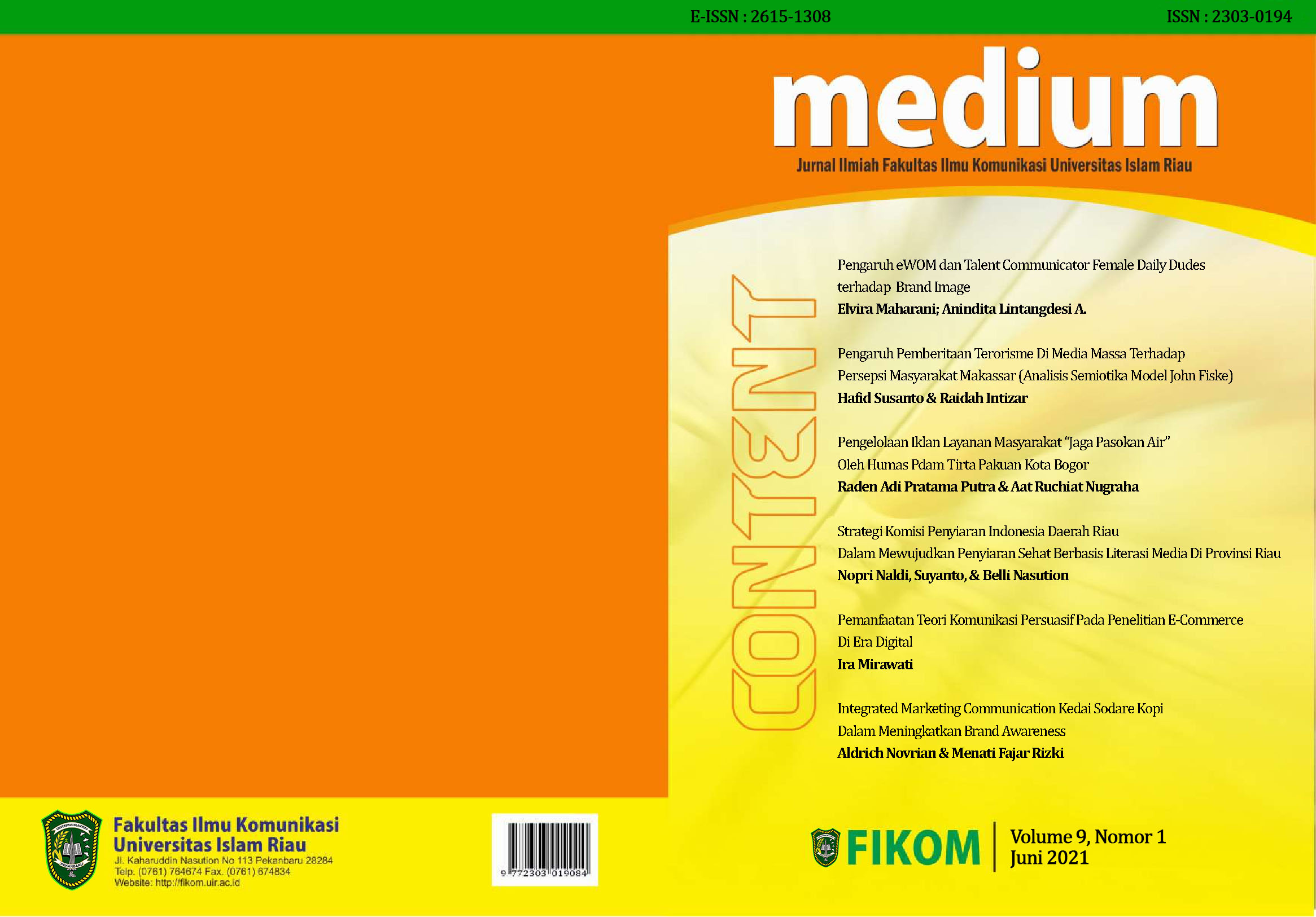THE EFFECT OF TERRORISM REPORTING IN MASS MEDIA ON THE PERCEPTION OF MAKASSAR COMMUNITY
DOI:
https://doi.org/10.25299/medium.2021.vol9(1).7442Keywords:
news reporting; terrorism; radicalismAbstract
The theory to be proven in this research is the hypodermic needle theory where media coverage can influence public perception, in this case terrorism and radicalism. Therefore, a quantitative study was prepared which aims to determine the effect of reporting on terrorism in the mass media on the perception of the people of Makassar. Respondents in this study were taken from the Makassar community, amounting to 1,469,601 according to the Makassar Central Statistics Agency. The sample selected in this study was 384 people with an error rate of 5%. The research data was obtained through a survey of respondents by distributing questionnaires. Then the data processing and analysis was carried out by simple linear regression analysis using the SPSS program. The results of this study indicate that there is an effect of reporting on terrorism in the mass media on the perception of the people of Makassar which is considered significant as the regression results obtained by the correlation/relationship value (R) which is 0.435. From the output, the coefficient of determination (R square) is 0.190, and the adjusted R square value is 0.187, which implies that the influence of the independent variable (news) on the dependent variable (perception) is 18.7%.
Downloads
References
Ardianto. (2007:50-58). Komunikasi Massa Suatu Pengantar. Bandung: Simbosa Rekatama Media.
B.N.P. (2016). Strategi Menghadapi Paham Radikalisme terorisme-ISIS. Belmawe, 2.
Bekti Nugroho, Samsuri. (2013). Pers Berkualitas, Masyarakat Cerdas. Jakarta Pusat: DEWAN PERS.
Cangara, H. (2011). Pengantar Ilmu Komunikasi. Jakarta: PT Raja Grafindo Persada.
Deddy Mulyana. (2014:92). Ilmu Komunikasi Suatu Pengantar. Bandung: PT. Remaja Rosdakarya.
Harahap, M. T. (2010). Berita Terorisme Dan Sikap Remaja Muslim (Studi Korela-sional tentang Pengaruh Berita Terorisme di TV One terhadap Sikap Remaja Muslim di SMA Al-Azhar Medan). Medan: Universitas Sumatera Utara.
I Basis Susilo & Zainal Arifin Emka. (2020). TERORISME Asumsi Dasar 21 Artikel. Jawa Timur: Airlangga University Press.
Morissan. (2013:7). teori komunikasi : individu hingga massa. Jakarta: Kencana.
Mulyana, D. (2014:261). Ilmu Komunikasi Suatu Pengantar. Bandung: PT. Remaja Rosdakarya.
Nurudin. (2011). Pengantar Komunikasi Massa. Jakarta: Rajawali Pers.
Nurudin. (2013). pengantar komunikasi massa. jakarta: PT. Raja Grafindo Persada.
Nurudin. (2014). Pengantar Komunikasi Massa. Jakarta: Rajawali Pers.
Prajarto, N. (2004). Terorisme dan Media Massa: Debat Keterlibatan Media. Jurnal llmu Sosial & llmu Politik, VoL 8, No. 1, Juli , 37-52.
Riswandi. (2009:3). Dasar Dasar Penyiaran. Yogyakarta: Graha Ilmu.
Siregar, Syofian. (2013:46). Metode Penelitian Kuantitatif. Jakarta: PT Fajar Inter-pratama Mandiri.
Solso, M. &. (2007). Psikologi Kognitif. Jakarta: Erlangga.
Sugiyono. (2013:118). Metode Penelitian Kuantitatif. Bandung: Alvabeta. CV.
Sukarno, A. W. (2011). Dilema Peliputan Terorisme dan Pergeseran Pola Framing Berita Terorisme di Media Massa. Jurnal Ilmu Sosial dan Ilmu Politik, Vol 14 No 3 Maret, 333-348.
Widyaningrum, A. Y. (2018). Terorisme Radikalisme Identitas Keindonesiaan. Jurnal Studi Komunikasi, 36-37.






